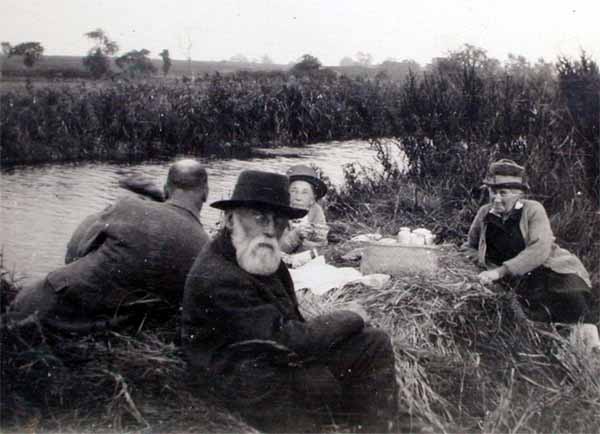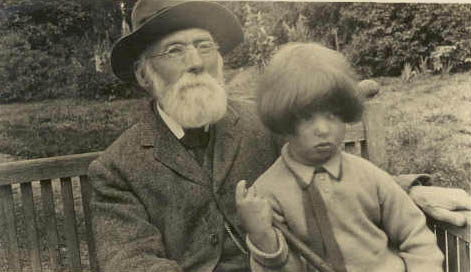
George
Thomas Rope: artist and naturalist 
Exhibition at Christchurch Mansion Ipswich until April 2024:
including works by G.T.Rope and E.M.Rope
Within the Rope family that grew at Grove Farm, Blaxhall, Suffolk, from the marriage of George Rope and Ann Pope, there were several artists. Most notable among these were George Thomas Rope, their eldest son, a landscape artist and naturalist and Ellen Mary Rope, third of four daughters, a sculptor. George Thomas (1846-1929) was uncle to the two Margarets (see family tree page).
George Thomas Rope's father (sometimes referred to as "Old George") was a farmer, corn merchant and small ship owner, based at Blaxhall as well as at Iken and Orford. George Thomas ("young George") was the first son of the family but was reputed to have a weak heart and this caused - or enabled - him to stay in the family home and develop his interests as an artist and a biologist.
At an early age, he developed a very keen interest in animals, an interest he strongly maintained throughout his life. As a boy, he studied Natural History whilst attending Ipswich Grammar School, where he also developed a keen interest in Art. Leaving school about the year 1862, he went to London to study in the studio of an artist named William Webb, with whom he remained for a year before returning to Suffolk. Little is known of his studies but Webb was said to be interested in landscape and animal painting, which became George Thomas's specialities too. Word is that George Thomas's historical artist heroes were Constable and Corot.
George Thomas Rope was a productive artist through much of his long life. He specialised in oils - and pencil sketches, in which he was particularly adept. He also did a smaller number of water colours. His subjects were country landscapes, particularly in East Suffolk, as well as animals, especially horses.
Apart from his art, he also wrote books on trees, mammals and the Suffolk dialect. He also contributed numerous articles to the Suffolk Naturist Society (that's what my notes say - maybe should be Naturalist) and Zoological Society. His knowledge of animals and reptiles was much respected and often consulted. He also wrote some poetry. In his early days, he played the 'cello and would sometimes play with his father (on violin) and his sisters, who were also musical.
In 1882, he visited the Continent of Europe where he executed numerous artistic studies - including in Holland and Normandy and at Dieppe. Nearer to home, he liked to roam over the Essex countryside, lodging with local people in localities such as Great Waltham and Layer Breton. In 1884, he toured the North of England, coming back with several views of Cumberland, which he exhibited at the Ipswich Art Society. In 1886 he visited Surrey and in 1890 toured in Kent and Berkshire.
Despite
his lack of physical strength, he insisted on painting from nature and would
struggle out with his paints and easel and as the years went by his health
became more and more of a problem. Later in his life he had a studio built
in the garden and he probably worked here more as time went by. 
He was a gentle man with intense love of animals and also children; he was reputedly never happier than when showing children his guinea pigs and doves. Although supported by family income, he was always pleased when someone asked to purchase one of his works. However, his art was not always kindly received. On one occasion in 1910 he overheard some "modern" painters making fun of the care he lavished on his pictures - this upset him so much that he did not send any further paintings to the (Ipswich?) Art Society: he was a very sensitive man.
In his time, he had exhibited three works at the Royal Academy: "Field Mice", "Evening - Early Spring" and "Suffolk Street" Despite his "weak heart", he remained active until the age of 83 and died as the result of an accident: he was found lying in the road within half a mile of his lifelong home. He had been driving out with pony and trap and the trap had overturned. An early motor car had been reported as being in the vicinity and perhaps the pony was spooked by it. Another version is that he pulled off the road to let the car go by and the trap mounted a piece of wood and turned over. He died the next day.
Wikipedia entry for George Thomas Rope
Much
of the above was derived from "The Dictionary of Victorian Painters", Christopher
Wood, 1978 (Pub: Antique Collectors Club, 5 Church Street, Woodbridge, Suffolk).
See also H.A.E.Day:"East Anglian Painters" Vol 1.
In fact, Mr Day's son, John Day, is the foremost collector and dealer in
George Rope's works and most knowledgeable about him. He has recently relocated
to Wickham Market, Suffolk and has established the East Anglian Traditional
Art Centre there. It is dedicated to "promoting research and enthusiasm":
it runs frequent exhibitions and offers related professional services and
advice.
The
website is www.eatac.co.uk. John Day is contactable at EATAC, 48 High Street,
Wickham Market, near Woodbridge, Suffolk, IP13 0QS or by phone: 07960-274139
or 01728-747050

George Thomas Rope with one of his nieces: Teresa Vaughan, near the end of his life and tragically close to the end of hers, too.